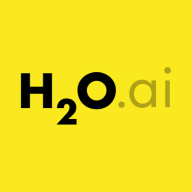

H2O.ai and Roboflow compete in the AI and machine learning domain. H2O.ai takes the lead with a broader appeal due to its diverse toolset, while Roboflow shines in computer vision.
Features: H2O.ai offers advanced machine learning algorithms, automatic feature engineering, and multi-platform scalability. Roboflow specializes in computer vision with easy dataset management, annotation tools, and strong model development integrations.
Ease of Deployment and Customer Service: H2O.ai provides flexible deployment options including cloud and on-premises, backed by extensive support materials. Roboflow focuses on user-friendly cloud-based deployment and offers responsive assistance.
Pricing and ROI: H2O.ai’s customizable plans reflect its capabilities, offering high ROI for data-driven enterprises. Roboflow’s competitive pricing attracts startups focused on computer vision, balancing affordability with specialized functionality.

| Company Size | Count |
|---|---|
| Small Business | 2 |
| Midsize Enterprise | 3 |
| Large Enterprise | 7 |
H2O is a fully open source, distributed in-memory machine learning platform with linear scalability. H2O’s supports the most widely used statistical & machine learning algorithms including gradient boosted machines, generalized linear models, deep learning and more. H2O also has an industry leading AutoML functionality that automatically runs through all the algorithms and their hyperparameters to produce a leaderboard of the best models. The H2O platform is used by over 14,000 organizations globally and is extremely popular in both the R & Python communities.
Roboflow is a comprehensive platform tailored for developers focusing on computer vision projects. Streamlining processes like data labeling, training, and deployment, it addresses the needs of tech-savvy individuals seeking efficiency and accuracy in their machine learning workflows.
Roboflow offers functionality that enhances the process of developing computer vision applications. Its ability to manage datasets, automate labeling tasks, and provide seamless integration with various machine learning models sets it apart. Users benefit from an intuitive system designed to reduce time spent on repetitive tasks. Currently, there's room for refinement in aspects like enhanced collaboration tools, potentially expanding its impact on large teams. Roboflow remains significant for tech users aiming to improve their machine learning projects.
What are the most important features of Roboflow?Roboflow finds application in industries like healthcare, automotive, and retail, each benefiting from its capabilities to streamline visual data processing. In healthcare, for instance, Roboflow aids in medical imaging tasks, whereas automotive fields utilize it for autonomous vehicle development. Its features enhance productivity and innovation across sectors, illustrating its critical role in tech-driven strategies.
We monitor all Data Science Platforms reviews to prevent fraudulent reviews and keep review quality high. We do not post reviews by company employees or direct competitors. We validate each review for authenticity via cross-reference with LinkedIn, and personal follow-up with the reviewer when necessary.